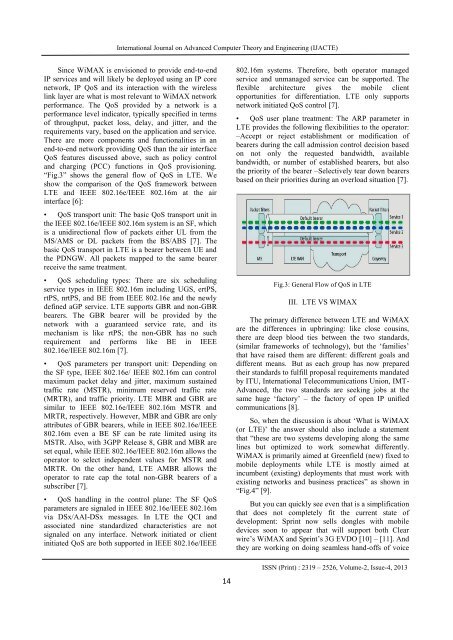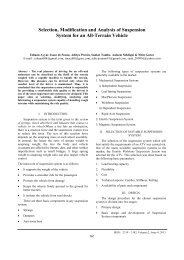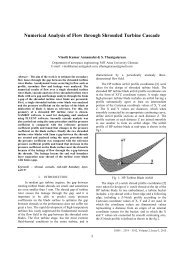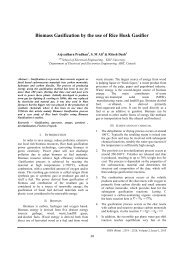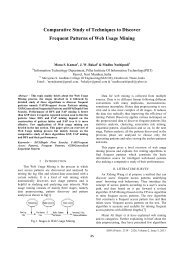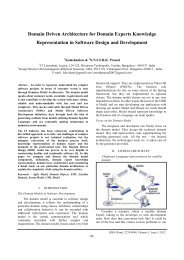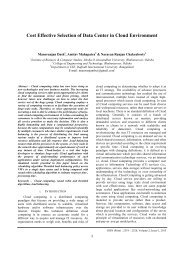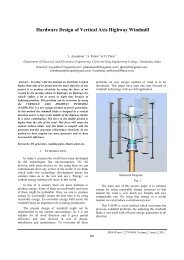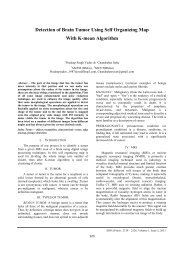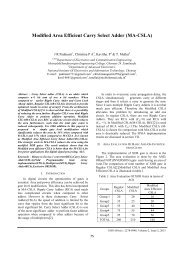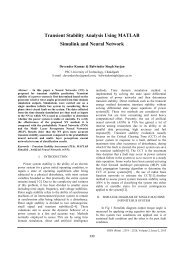Evolutionary Comparison of LTE over WiMAX - IRD India
Evolutionary Comparison of LTE over WiMAX - IRD India
Evolutionary Comparison of LTE over WiMAX - IRD India
Create successful ePaper yourself
Turn your PDF publications into a flip-book with our unique Google optimized e-Paper software.
International Journal on Advanced Computer Theory and Engineering (IJACTE)Since <strong>WiMAX</strong> is envisioned to provide end-to-endIP services and will likely be deployed using an IP corenetwork, IP QoS and its interaction with the wirelesslink layer are what is most relevant to <strong>WiMAX</strong> networkperformance. The QoS provided by a network is aperformance level indicator, typically specified in terms<strong>of</strong> throughput, packet loss, delay, and jitter, and therequirements vary, based on the application and service.There are more components and functionalities in anend-to-end network providing QoS than the air interfaceQoS features discussed above, such as policy controland charging (PCC) functions in QoS provisioning.―Fig.3‖ shows the general flow <strong>of</strong> QoS in <strong>LTE</strong>. Weshow the comparison <strong>of</strong> the QoS framework between<strong>LTE</strong> and IEEE 802.16e/IEEE 802.16m at the airinterface [6]:• QoS transport unit: The basic QoS transport unit inthe IEEE 802.16e/IEEE 802.16m system is an SF, whichis a unidirectional flow <strong>of</strong> packets either UL from theMS/AMS or DL packets from the BS/ABS [7]. Thebasic QoS transport in <strong>LTE</strong> is a bearer between UE andthe PDNGW. All packets mapped to the same bearerreceive the same treatment.• QoS scheduling types: There are six schedulingservice types in IEEE 802.16m including UGS, ertPS,rtPS, nrtPS, and BE from IEEE 802.16e and the newlydefined aGP service. <strong>LTE</strong> supports GBR and non-GBRbearers. The GBR bearer will be provided by thenetwork with a guaranteed service rate, and itsmechanism is like rtPS; the non-GBR has no suchrequirement and performs like BE in IEEE802.16e/IEEE 802.16m [7].• QoS parameters per transport unit: Depending onthe SF type, IEEE 802.16e/ IEEE 802.16m can controlmaximum packet delay and jitter, maximum sustainedtraffic rate (MSTR), minimum reserved traffic rate(MRTR), and traffic priority. <strong>LTE</strong> MBR and GBR aresimilar to IEEE 802.16e/IEEE 802.16m MSTR andMRTR, respectively. However, MBR and GBR are onlyattributes <strong>of</strong> GBR bearers, while in IEEE 802.16e/IEEE802.16m even a BE SF can be rate limited using itsMSTR. Also, with 3GPP Release 8, GBR and MBR areset equal, while IEEE 802.16e/IEEE 802.16m allows theoperator to select independent values for MSTR andMRTR. On the other hand, <strong>LTE</strong> AMBR allows theoperator to rate cap the total non-GBR bearers <strong>of</strong> asubscriber [7].• QoS handling in the control plane: The SF QoSparameters are signaled in IEEE 802.16e/IEEE 802.16mvia DSx/AAI-DSx messages. In <strong>LTE</strong> the QCI andassociated nine standardized characteristics are notsignaled on any interface. Network initiated or clientinitiated QoS are both supported in IEEE 802.16e/IEEE802.16m systems. Therefore, both operator managedservice and unmanaged service can be supported. Theflexible architecture gives the mobile clientopportunities for differentiation. <strong>LTE</strong> only supportsnetwork initiated QoS control [7].• QoS user plane treatment: The ARP parameter in<strong>LTE</strong> provides the following flexibilities to the operator:–Accept or reject establishment or modification <strong>of</strong>bearers during the call admission control decision basedon not only the requested bandwidth, availablebandwidth, or number <strong>of</strong> established bearers, but alsothe priority <strong>of</strong> the bearer –Selectively tear down bearersbased on their priorities during an <strong>over</strong>load situation [7].Fig.3: General Flow <strong>of</strong> QoS in <strong>LTE</strong>III. <strong>LTE</strong> VS WIMAXThe primary difference between <strong>LTE</strong> and <strong>WiMAX</strong>are the differences in upbringing: like close cousins,there are deep blood ties between the two standards,(similar frameworks <strong>of</strong> technology), but the ‗families‘that have raised them are different: different goals anddifferent means. But as each group has now preparedtheir standards to fulfill proposal requirements mandatedby ITU, International Telecommunications Union, IMT-Advanced, the two standards are seeking jobs at thesame huge ‗factory‘ – the factory <strong>of</strong> open IP unifiedcommunications [8].So, when the discussion is about ‗What is <strong>WiMAX</strong>(or <strong>LTE</strong>)‘ the answer should also include a statementthat ―these are two systems developing along the samelines but optimized to work somewhat differently.<strong>WiMAX</strong> is primarily aimed at Greenfield (new) fixed tomobile deployments while <strong>LTE</strong> is mostly aimed atincumbent (existing) deployments that must work withexisting networks and business practices‖ as shown in―Fig.4‖ [9].But you can quickly see even that is a simplificationthat does not completely fit the current state <strong>of</strong>development: Sprint now sells dongles with mobiledevices soon to appear that will support both Clearwire‘s <strong>WiMAX</strong> and Sprint‘s 3G EVDO [10] – [11]. Andthey are working on doing seamless hand-<strong>of</strong>fs <strong>of</strong> voice14ISSN (Print) : 2319 – 2526, Volume-2, Issue-4, 2013


